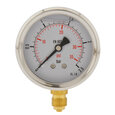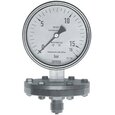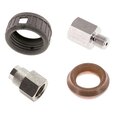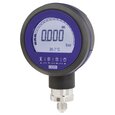How Does a Digital Pressure Gauge Work?

Figure 1: Digital pressure gauge
Digital pressure gauges measure the pressure in a system and display the value on an integrated digital display. These gauges are more accurate and easier to read than traditional mechanical gauges and can store and transmit pressure data electronically. They are often used in a variety of industrial, scientific, and medical applications to measure the pressure of gasses, liquids, or vapors in tanks, pipes, or other containers.
Table of contents
- Working principle
- Why choose a digital over an analog pressure gauge?
- Digital pressure gauge accuracy
- FAQs
View our online selection of pressure gauges!
Working principle
Digital pressure gauges use pressure sensors that convert pressure to an equivalent electronic signal. Different types of pressure sensors are suitable for digital gauges; however, piezoresistive pressure sensors are used most frequently due to their robust design and lower price than capacitive sensors.
A piezoresistive pressure sensor consists of a diaphragm equipped with piezoresistive elements. The pressure of the medium causes the diaphragm to deflect; this deflection causes a change in the cross-sectional area of the piezoresistive elements that changes the material’s electrical resistance creating a voltage difference. The gauge's internal microprocessor then processes the voltage to display a pressure reading on the digital display.
Some digital gauges also have additional features such as temperature compensation, data logging, and wireless connectivity. Read our electronic pressure measurement principles article for an in-depth guide on how different sensor types work.
Why choose a digital over an analog pressure gauge?
Next to a higher level of measurement accuracy, digital gauges offer multiple options that are not available with their analog counterparts.
- Backlighting: Backlighting helps a user read the display in every lighting condition, especially dark conditions.
- Min/Max values: Digital gauges can display the maximum and minimum readings simultaneously with the current reading or separately. This option provides a better analysis of the set pressure in a system.
- Bargraph display: The bar graph display shows the general trend of the measured pressure. For example, a user can quickly analyze whether the system pressure tends to increase, decrease, or remain steady.
- Battery-powered: Digital gauges are battery-operated. This ensures that the pressure can be read even in case of a power outage.
- Rotation: Most digital gauges allow for the display unit to be rotated to a large degree (e.g., 300°)
Read our pressure gauge selection article to learn more about selecting a pressure gauge. For more information on various types of gauges, read our bellows pressure gauges, diaphragm pressure gauges, or bourdon tube pressure gauges articles.
Digital pressure gauge accuracy
A digital pressure gauge’s accuracy is how closely the pressure’s measured value matches the pressure’s actual value. It is typically expressed as a percentage of the measurement span (the difference between the upper and lower measurement limits).
A digital pressure gauge with high accuracy will have a slight deviation between the measured and actual values. In contrast, a digital pressure gauge with low accuracy will have a more significant deviation. The accuracy of these gauges is a combination of multiple factors:
- non-linearity
- hysteresis
- end value deviation
- zero offsets, and
- span error
Read our pressure measurement accuracy article for more details on accuracy and measuring errors.
FAQs
What is an electronic pressure gauge?
Electronic pressure gauges or digital pressure gauges use sensors that convert pressure to an equivalent electronic signal and display the value using an inherent digital display.
What is a high-precision digital pressure gauge?
This is a device with a high-precision sensor that accurately displays pressure in real-time.











